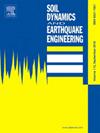Shaking table experiments to investigate the seismic response of drag embedded anchors
IF 4.6
2区 工程技术
Q1 ENGINEERING, GEOLOGICAL
引用次数: 0
Abstract
Drag embedded anchors (DEA) are widely used in offshore engineering. The anchor foundations are installed in the seabed through the drag force applied by the mooring line and provide holding capacity to marine structures. Offshore wind farms in Taiwan are located in active earthquake zones, where a considerable amount of sandy soil at the upper layer of seabed results in a high potential for soil liquefaction. Since DEA are a promising option for floating wind turbines, this study conducted a shaking table test on two 1/30-scale anchors in medium dense sand to investigate the dynamic behavior of DEA during earthquakes and after excess pore water pressure dissipation. The test results reveal no significant impact on the orientation of the anchors, which could be due to the uplift force from the excess pore water pressure acting on the fluke. After the excess pore water pressure dissipates, the soil density increases, and the fluke angle becomes favorable, thus increasing the anchor's holding capacity when subjected to additional drag.
采用振动台试验研究了锚杆的地震响应
拖曳式锚杆在海洋工程中应用广泛。锚基础通过系泊绳施加的拖曳力安装在海底,为海洋结构物提供承载能力。台湾的海上风电场位于地震活跃地带,海床上层有大量的沙质土壤,导致土壤液化的可能性很大。由于DEA是浮式风力发电机组的一种很有前途的选择,本研究在两个1/30比例尺的中密度砂土锚杆上进行了振动台试验,研究了DEA在地震和超孔隙水压力消散后的动力行为。试验结果表明,锚的方向没有明显的影响,这可能是由于超孔隙水压力对锚爪的抬升力造成的。当超孔隙水压力消散后,土体密度增大,锚爪角趋于有利,增加了锚在附加阻力作用下的持力。
本文章由计算机程序翻译,如有差异,请以英文原文为准。
求助全文
约1分钟内获得全文
求助全文
来源期刊

Soil Dynamics and Earthquake Engineering
工程技术-地球科学综合
CiteScore
7.50
自引率
15.00%
发文量
446
审稿时长
8 months
期刊介绍:
The journal aims to encourage and enhance the role of mechanics and other disciplines as they relate to earthquake engineering by providing opportunities for the publication of the work of applied mathematicians, engineers and other applied scientists involved in solving problems closely related to the field of earthquake engineering and geotechnical earthquake engineering.
Emphasis is placed on new concepts and techniques, but case histories will also be published if they enhance the presentation and understanding of new technical concepts.
 求助内容:
求助内容: 应助结果提醒方式:
应助结果提醒方式:


